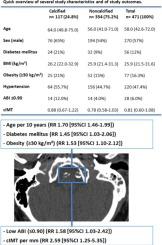Journal of Neuroradiology ( IF 3.5 ) Pub Date : 2020-03-10 , DOI: 10.1016/j.neurad.2020.02.004 Tim C van den Beukel 1 , Carlo Lucci 1 , Jeroen Hendrikse 1 , Wilko Spiering 2 , Huiberdina L Koek 3 , Mirjam I Geerlings 4 , Pim A de Jong 1 ,

|
Background and purpose
Vertebrobasilar artery calcification (VBAC) has been associated with increased stroke occurrence. Little is known on VBAC risk factors, especially for patients with cardiovascular disease. We aimed to assess risk factors associated with VBAC in a cohort of cardiovascular patients referred for a head computed tomography (CT) scan.
Materials and methods
All patients who underwent a clinically indicated, unenhanced, thin slice head CT 6 months before or after inclusion in the SMART study were included. CTs were assessed for presence of VBAC (dichotomously). Relative risks of the associations of age, sex, diabetes mellitus (DM), obesity, body mass index, estimated glomerular filtration rate, hypertension, hyperlipidemia, use of lipid lowering medication, smoking status, high sensitivity C-reactive protein, ankle-brachial index (ABI; ≤ 0.90, ≥ 1.30, continuous), internal carotid artery stenosis ≥ 70%, and carotid intima-media thickness (IMT) with VBAC were estimated using Poisson regression analysis with robust standard errors, adjusted for age and sex.
Results
Of the 471 patients included (57% male, median age 58 [interquartile range 47–63]), 117 (24.8%) showed VBAC. Presence of VBAC was associated with older age (RR per 10 years = 1.70 [95%CI 1.46–1.99]), DM (RR = 1.45 [95%CI 1.03–2.06]), obesity (RR = 1.53 [95%CI 1.10–2.12]), ABI ≤ 0.90 (RR = 1.57 [95%CI 1.02–2.41]), and an increased carotid IMT (RR = 2.60 per mm [95%CI 1.20–5.62]). Other measurements were not associated with VBAC.
Conclusions
We identified several markers associated with VBAC in patients with cardiovascular disease referred for a head CT. Future investigation into the relationship between VBAC and stroke is warranted to determine the potential of VBAC in stroke prevention.
中文翻译:

SMART 研究转诊进行头部 CT 的心血管患者椎基底动脉钙化的危险因素
背景和目的
椎基底动脉钙化 (VBAC) 与卒中发生率增加有关。对 VBAC 危险因素知之甚少,尤其是对于心血管疾病患者。我们的目的是在一组转诊进行头部计算机断层扫描 (CT) 扫描的心血管患者中评估与 VBAC 相关的危险因素。
材料和方法
所有在纳入 SMART 研究之前或之后 6 个月接受过有临床指征的、未增强的、薄层头部 CT 的患者都被包括在内。评估 CT 是否存在 VBAC(二分法)。年龄、性别、糖尿病 (DM)、肥胖、体重指数、估计的肾小球滤过率、高血压、高脂血症、降脂药物的使用、吸烟状况、高敏 C 反应蛋白、踝臂动脉的相关性的相对风险指数(ABI;≤ 0.90,≥ 1.30,连续)、颈内动脉狭窄 ≥ 70% 和颈动脉内中膜厚度 (IMT) 与 VBAC 使用泊松回归分析与稳健的标准误差估计,调整了年龄和性别。
结果
在包括的 471 名患者中(57% 男性,中位年龄 58 [四分位距 47-63]),117 名 (24.8%) 显示 VBAC。VBAC 的存在与年龄较大(RR 每 10 年 = 1.70 [95%CI 1.46–1.99])、DM(RR = 1.45 [95%CI 1.03–2.06])、肥胖(RR = 1.53 [95%CI 1.10 ])相关–2.12]),ABI ≤ 0.90(RR = 1.57 [95%CI 1.02–2.41]),颈动脉 IMT 增加(RR = 2.60/mm [95%CI 1.20–5.62])。其他测量与 VBAC 无关。
结论
我们在转诊进行头部 CT 的心血管疾病患者中发现了几个与 VBAC 相关的标志物。有必要进一步研究 VBAC 与中风之间的关系,以确定 VBAC 在预防中风方面的潜力。



























 京公网安备 11010802027423号
京公网安备 11010802027423号